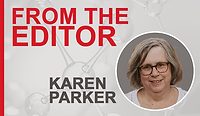From the Editor
Old Friends, New Developments in the Adhesives Industry

April and the first part of May are big months for the adhesive and sealant industry. I like to think of it as the four weeks of big events. The middle of April will find many members of this community gathering at the annual ASC Convention and EXPO, held this year in Jacksonville, Florida. Adhesive manufacturers and those involved in assembly technology will also meet in Nashville for the co-located Assembly Show South, Quality Show, and the new Adhesives in Action event. And then, members of this community who provide technology for tape manufacturers will be gathering outside of Chicago for Tape Week 2025.
I am looking forward to each of these events. Getting a glimpse of the new research and technology available to this industry is always exciting, and it is always nice to see people in person and be reminded again that there is a person behind emails!
2025 is shaping up to be a year of potentially big change in many areas, including within the chemical industry and the manufacturing industry, and I am very interested to see what professionals in your industry have to say about what they are looking forward to in the next nine months and what challenges they think might be on the horizon. I am hoping to get some great insight by listening to you at these events.
In the spirit of all the technical presentations we have to look forward to in the four weeks of big events, I thought I would share two pieces of research I think might be of interest.
The first piece of research news comes from scientists at Colorado State University, who have developed a biodegradable and reusable adhesive polymer that is reported to be stronger than the currently available commercial options. In a paper published in the journal Science, the researchers describe how poly(3-hydroxybutyrate), or P3HB, a naturally occurring bio-based and biodegradable polymer, can be re-engineered and used as a bonding agent. This technology could provide a solution to the problem of recycling of plastic with adhesive labels.
Colorado State University Distinguished Professor Eugene Chen, of the university’s Department of Chemistry, worked to chemically re-engineer the structure of P3HB so that it can provide stronger adhesives than petroleum-derived options that are nonbiodegradable. so that it can lead to adhesives that are stronger than their nonbiodegradable, petroleum-derived counterparts. "Petroleum-based thermoset adhesives such as Gorilla Glue and J-B Weld, along with thermoplastic hot melts, can be very difficult or even impossible to recycle or recover – primarily because of their strong bonds to other materials,” he said. “Our approach instead offers a biodegradable material that can be used in a variety of industries with tunable or even higher strength compared to those options," explained Chen.
In research news a few steps removed from adhesive formulation, but still relevant, Feng Jiao, a professor at Washington University in St. Louis, developed a two-step process to convert carbon dioxide into valuable materials like acetate and ethylene. His tandem CO2 electrolysis method, detailed in a study published in Nature Chemical Engineering, successfully scaled up to produce a kilogram of chemicals per day, marking a significant increase in production scale and demonstrating commercial viability through a techno-economic analysis.
“This is the first step in scaling up to commercial applications,” Jiao said. “We’re trying to invent a scalable way to produce acetate from CO2, which would allow us to shift carbon feedstocks, provide economical pathways to use CO2 and turn it into something useful, and cut down CO2 emissions associated with traditional chemical manufacturing processes. This new pathway gets us very close to net-zero carbon emission.”
This issue of ASI includes features about the events coming up in April and May, several articles touching on the assembly process -- including an article about plasma "pens" for in-line curing. Also included is an article by Bostik about alternative thermally conductive gap fillers for EV applications and an article explaining how multifunctional additives can optimize coatings formulations, submitted by Microban International. I hope you enjoy this issue, and I will see you at all the events in April and May!
Looking for a reprint of this article?
From high-res PDFs to custom plaques, order your copy today!






